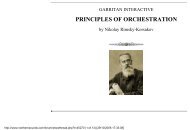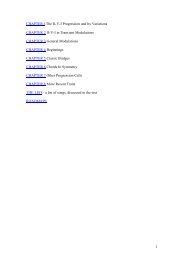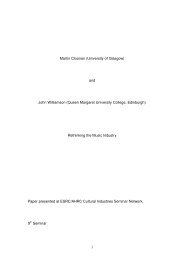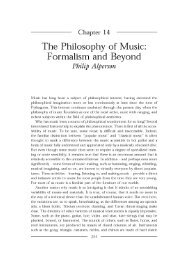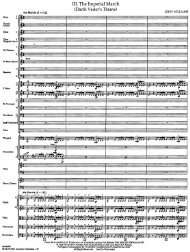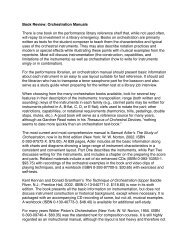TWENTIETH- - Synapse Music
TWENTIETH- - Synapse Music
TWENTIETH- - Synapse Music
You also want an ePaper? Increase the reach of your titles
YUMPU automatically turns print PDFs into web optimized ePapers that Google loves.
164 Imports and Allusions<br />
Quotation in Bernd Alois Zimmermann 's music is an important stylistic element<br />
rather than the exceptional event, a good example being Photoptosis ( 1968), an orchestral<br />
work with quotations from various sources. In Petroushkates (1980), Joan Tower has composed<br />
a sort of paraphrase variation on Stravinsky's original. Direct quotations in<br />
Pelrotlshkales are most apparent at the beginning, but chords, rh ythms, and melodic fi gures<br />
drawn from Stravinsky can be heard throughout the work, most of which maintai ns the exhilarating<br />
spirit of the opening of PelrushlaJ.<br />
Bach's Partita in E Major for solo violin serves as the basis for the third movement of<br />
Lukas Foss's Baroque Variations (1967). Far removed from the traditional theme and variations,<br />
this dramatic and effective work often views the Bach work through a wi ldly distorted<br />
lens. Chapter 14 includes additional discussion of this movement.<br />
Perhaps the most famou s example of quotation is the third movement of Berio's Sinfonia<br />
(1968), a work for eight voices and orchestra. The entire movement is based on the<br />
third movement of Mahler's Symphony No.2 (1 894), sometimes obviously but often more<br />
subtly, with additional quotations from Bach, Berg, Brahm" Debussy, Ravel, Schoenberg,<br />
Strauss, Stravinsky, and others, these quotations being alJuded to on occasion by the chorus.<br />
7 Most of the text, however, is drawn from Samuel Beckett's novel The Unnameable.<br />
The connections between Mahler, Joyce, Beckett, and Berio have been convincingly<br />
shown, including the suggestion th at Joyce's stream· of-consciousness style of writing has<br />
its parallel in Mahler's music, and presumably in Berio's as well. 8 The result is a musical<br />
col1age but also a complex and fascinating work, much more than a haphazard pastiche.<br />
Alfred Schnittke is a Russian composer who has been using quotations and stylistic<br />
allusions in his music since the late 1960s, one example among many being his Moz-arl, a<br />
blend of Mozartean gestures and twentieth-century dissonances, muJtiphonics, and other<br />
effects. His use of earlier materials is sometimes humorous and sometimes serious.<br />
Sometimes I'm tweaking the li stener. And sometimes I'm thinking about earlier<br />
music as a beautiful way of writing that has disappeared and will never come back;<br />
and in that sense, it has a tragic feeling for me. 9<br />
INFLUENCES FROM FOLK MUSIC, JAZZ,AND ROCK<br />
Composers of the nineteenth century were certainly not unaware of folk music, as witnessed<br />
by the influence of Polish folk music on Chopin and the arrangements of German<br />
folk songs by Brahms. The rise of nationalism in the late nineteenth century spawned an<br />
increased interest on the part of composers of all countries in the music that was indigenous<br />
to their own cultures, and this interest continued into the twentieth centwy, especially<br />
in the fi rst several decades.<br />
Probably the composer whose name first come, to mind in connection with folk<br />
music in the twentieth century is Bela Bart6k. Shortly after the beginning of the century, he<br />
and his compatriot ZoMn Kodaly began a serious study of folk music, at first only Hungarian,<br />
but soon including that of neighboring countries as well. Bart6k's interest in this<br />
area is seen explicitly in the titles of many of his works; for example, the following titles<br />
appear in Volumes 4-6 of the Mikrokosmos:



